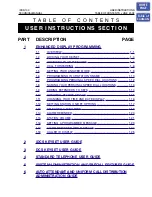
Spectralink 80-Series Handsets Administration Guide with SRP
1725-86030-000_G.docx
October 2013
65
Dial Tone Problems
A dial tone problem exists if the handset has no dial tone or if the user is unable to hear the
other party’s voice, hears echo or hears dead air. Dial tone problems can be caused by a
number of different situations and should be investigated by following these steps:
1
Power on the handset in an active service area. If the handset does not get a dial tone in
an active area, continue with the steps below. If the no dial tone problem is limited to a
certain area, see Chapter 9, section
Access Point Problems
.
Any initialization or error messages should turn off a few seconds after the handset is
powered on.
2
Swap the Battery Pack with a Battery Pack from a functional handset, power the handset
back on and check for dial tone. If this corrects the problem, try recharging the Battery
Pack that was removed.
3
Turn the handset off, then on again, and then test again for dial tone. If functioning,
place a call and determine voice quality.
4
While maintaining an active call, walk through several AP areas. If fluctuation occurs see
Chapter 9, section
Access Point Problems
.
5
Check for alarms on the Spectralink 80-Series Telephony Gateway or the Spectralink
80-Series SVP Server (via System Status). If there are alarms, see
Spectralink
80-Series Telephony Gateway: Administration Guide for SRP
or
Spectralink 80-Series
SVP Server: Administration Guide for SRP
for information.
6
Make sure the handset’s gateway port is connected to a working telephone line. Check
the line at the demarc block. You may need to contact your vendor to perform this check.
7
Check the cabling between the gateway and the demarc block and between the demarc
block and the telephone system ports.
8
Move the handset to a different port location and test again.















































